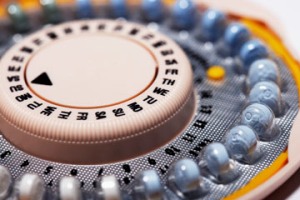With the risk of blood clots and other complications following weight loss surgery, women are having to find other options than a typical estrogen-based contraceptive to prevent pregnancy. Estrogen-based contraceptives, like Ortho-Tri-Cyclen, that contain ethinyl estradiol are more likely to cause blood clots and increase blood pressure. But don’t fret, there are a lot of options available.
Estrogen-free birth controls, or progestin-only birth controls, only contain one form of hormone but are still effective in preventing pregnancy. These are a good option for those who are overweight, have high blood pressure and are at risk for blood clots. Weight loss surgery patients probably have at least two of these three issues.
Oral contraceptives include Jolivette, also known as Ortho-Micronor, which is taken daily; the Depo-provera shot, which is administered in a doctor’s office every three months; and Mirena, the intrauterine device or IUD. One concern with progestin birth controls is the increase risk of weight gain. This is usually pretty minimal and can be controlled with proper nutrition and exercise.
IUDs like Mirena and Paragard are inserted by a doctor and can prevent pregnancy for up to ten years. Paragard works by releasing copper into the uterus and interfering with sperm reaching an egg. There are risks like pelvic inflammatory disease and this usually occurs within twenty days of it being inserted. Pelvic inflammatory disease could increase the risk of an ectopic pregnancy, when the fertilized eggs grows inside the fallopian tube, or becoming infertile.
Diaphragms that look like a cup are used to cover up the cervix to prevent sperm from traveling into the uterus. As women come in all shapes and sizes so do diaphragms and you will need to be measured by your doctor for this. You can leave a diaphragm in for up to 24 hours, anything more than that and you increase the risk of toxic shock syndrome.
Spermicide should also be used every two hours to help prevent pregnancy. Spermicides come in gels, foams, creams, films and jellies and are inserted vaginally before sex. The idea is that is kills the sperm and it can be used in conjunction with condoms. Using this device perfectly yields a 91% success rate of preventing pregnancy but does not protect against all STDs.
A cervical cap is similar to the diaphragm and can be inserted vaginally for up to 48 hours. It is harder to insert than a diaphragm so it may not be as effective as a diaphragm.
Condoms come in both a female and male variety, though male condoms are much more commonly used. They come in all different colors and flavors. Condoms are not the most effective form of birth control but can help against spreading of STDs, like HIV. This is especially important if you haven’t talked to your partner about their sexual and medical history. Protect yourself!
There are male birth controls currently under development and procedures such as vasectomy that can prevent pregnancy. The mechanisms that scientists are investigating are preventing a male from producing sperm, decreasing the motility of the sperm and interfering with a sperm fertilizing an egg.
Women who are in their child bearing years (18-45) account for almost eighty-three percent of all weight loss surgeries. Many obese women are unable to have children because their weight has made them infertile and their hope is that weight loss surgery will reverse that like it does for type 2 diabetes. The recommendation however is to wait at least eighteen months post surgery to trying conceiving. These surgeries decrease the size of the stomach making it difficult to meet the nutritional needs of one person, much less two. It’s important to have a plan in place and talk to your doctor before you have your weight loss surgery. Planning is the key to preventing an unwanted pregnancy.
Also Read:
Birth Control Benefits Extend Beyond Preventing Pregnancy
